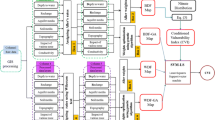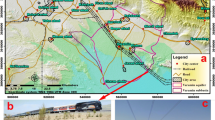Abstract
Declining groundwater levels due to the absence of a planning system makes aquifers vulnerable to subsidence. This paper investigates possible hotspots in terms of Subsidence Vulnerability Indices (SVI) by applying the ALPRIFT framework, introduced recently by the authors by mirroring the procedure for the DRASTIC framework. ALPRIFT is suitable to cases, where data is sparse, and is the acronym of seven data layers to be presented in due course. It is a scoring technique, in which each data layer bears an aspect of land subsidence and is prescribed with rates to account for local variability, and with prescribed weights to account for relative significance of the data layer. The inherent subjectivity in prescribed weights is treated in this paper by learning their values from site-specific data by the strategy of using artificial intelligence to learn from multiple models (AIMM). The strategy has two levels: (i) at Level 1, three fuzzy models are used to learn weight values from the local data and from observed target data, and (ii) at Level 2, genetic expression algorithm (GEP) is used to learn further, in which the outputs of the models at Level 1 are reused as its inputs and observed data as its target values. The results show that (i) the Nash-Sutcliff Efficiency (NSE) coefficient for ALPRIFT with measured land subsidence values is approx. 0.21; (ii) NSE is improved to 0.88 by learning the weights at Level 1 using fuzzy logic, and (iii) NSE is further improved to 0.94 by further learning at Level 2 using GEP.






Similar content being viewed by others
References
Aller L, Bennett T, Lehr JH, Petty R, Hackett G (1987) DRASTIC: a standardized system for evaluating ground water pollution potential using hydrogeologic settings, EPA 600/2–87-035. U.S. Environmental Protection Agency, Ada
Anumba CJ, Scot DT (2001) Performance evaluation of a knowledge-based system for subsidence management. Struct Surv 19:222–232. https://doi.org/10.1108/02630800110412462
ARWA, (2016) The data supplied by the Ardabil Regional Water Authority (ARWA) to the authors
Asadi S, Hassan M, Nadiri A, Dylla H (2014) Artificial intelligence modeling to evaluate field performance of photocatalytic asphalt pavement for ambient air purification. J Environ Sci Pollut Res 21(14):8847–8857. https://doi.org/10.1007/s11356-014-2821-z
Avila-Olivera JA, Garduño-Monroy VH (2008) A GPR study of subsidence-creep-fault processes in Morelia, Michoacán, Mexico. Eng Geol 100(1–2):69–81. https://doi.org/10.1016/j.enggeo.2008.03.003
Bezdek JC (1981) Pattern recognition with fuzzy objective function algorithms. Plenum Press, New York. https://doi.org/10.1007/978-1-4757-0450-1
Chiu S (1994) Fuzzy model identification based on cluster estimation. J Intell Fuzzy Syst 2:267–278
Colazas XC, Strehle RW (1995) Subsidence in the Wilmington Oil Field, Long Beach, California, USA. Dev Pet Sci 41:285–335. https://doi.org/10.1016/S0376-7361(06)80053-1
Cui ZD, Tang YQ (2010) Land subsidence and pore structure of soils caused by the high-rise building group through centrifuge model test. Eng Geol 113(1–4):44–52. https://doi.org/10.1016/j.enggeo.2010.02.003
Desir G, Gutiérrez F, Merino J, Carbonel D, Benito-Calvo A, Guerrero J, Fabregat I (2018) Rapid subsidence in damaging sinkholes: measurement by high-precision leveling and the role of salt dissolution. Geomorphology 503:393–409
Doğan U (2005) Land subsidence and caprock dolines caused by subsurface gypsum dissolution and the effect of subsidence on the fluvial system in the Upper Tigris Basin (between Bismil–Batman, Turkey). Geomorphology 71:389–401
Fernández-Camacho R, Cabeza IB, Aroba J, Gómez-Bravo F, Rodríguez S, de la Rosa J (2015) Assessment of ultrafine particles and noise measurements using fuzzy logic and data mining techniques. Sci Total Environ 512:103–113. https://doi.org/10.1016/j.scitotenv.2015.01.036
Fijani E, Nadiri AA, Asghari Moghaddam A, Tsai F, Dixon B (2013) Optimization of DRASTIC method by supervised committee machine artificial intelligence to assess groundwater vulnerability for Maragheh-Bonab plain aquifer Iran. J Hydrol l53:89–100. https://doi.org/10.1016/j.jhydrol.2013.08.038
Galloway D, Jones D, Ingebritsen SE (1999) Land subsidence in the United State. U.S. Department of the Interior, U.S. Geological Survey. Circular 1182:175. https://pubs.usgs.gov/circ/circ1182/pdf/circ1182_intro.pdf
Ghorbani MA, Khatibi R, Yousefi AH (2012) Inter-comparison of an evolutionary programming model of suspended sediment time-series with other local models. Book chapter: Genetic programming - new approaches and successful applications. https://doi.org/10.5772/47801
Goh ATC, Zhang RH, Wang W, Wang L, Liu HL, Zhang WG (2019) Numerical study of the effects of groundwater drawdown on ground settlement for excavation in residual soils. Acta Geotech. https://doi.org/10.1007/s11440-019-00843-5
Gu K, Shi B, Liu C, Jiang H, Li T, Wu J (2018) Investigation of land subsidence with the combination of distributed fiber optic sensing techniques and microstructure analysis of soils. Eng Geol 240(5):34–47. https://doi.org/10.1016/j.enggeo.2018.04.004
Hardin G (1968) The tragedy of the commons. Science 162(3859):1243–1248
Hayashi T, Tokunag T, Aichi M, Shimada J, Taniguchi M (2009) Effects of human activities and urbanization on groundwater environments: an example from the aquifer system of Tokyo and the surrounding area. Sci Total Environ 407(9:3165–3172
Iran National Cartographic Centre (2013) Landuse report of East Azerbaijan
Khatibi R, Ghorbani MT, Aalami MA, Kocak K, Makarynskyy O, Makarynska D, Aalinezhad D (2011a) Dynamics of hourly sea level at Hillary Boat Harbour, Western Australia: a chaos theory perspective. J Ocean Dyn 61(11):1797–1807 (http://www.springerlink.com/content/y1xq053633217222/)
Khatibi R, Ghorbani M, Hesenpur MK, Kişi Ö (2011b) Comparison of three artificial intelligence techniques for discharge routing. J Hydrol 403:201–212. http://www.sciencedirect.com/science/article/pii/S0022169411001673
Khatibi R, Sivakumar B, Ghorbani MA (2012) Investigating chaos in river stage and discharge time series. J Hydrol 414–415:108–117. https://doi.org/10.1016/j.jhydrol.2011.10.026
Khatibi R, Ghorbani MA, Akhoni Pourhosseini F (2017) Stream flow predictions using nature-inspired firefly algorithms and a multiple model strategy – directions of innovation towards next generation practices. Adv Eng Inform 34:80–89. https://doi.org/10.1016/j.aei.2017.10.002
Kihm JH, Kim JM, Song SH, Lee GS (2007) Three-dimensional numerical simulation of fully coupled groundwater flow and land deformation due to groundwater pumping in an unsaturated fluvial aquifer system. J Hydrol 335:1–14. https://doi.org/10.1016/j.jhydrol.2006.09.031
Koza JR (1994) Genetic programming as a means for programming computers by natural selection. Stat Comput 4:87–112
Larsen PM (1980) Industrial applications of fuzzy logic control. International Journal of Man-Machine Studies 12:3–10. https://doi.org/10.1016/S0020-7373(80)80050-2
Larson KJ, Barasaoslu H, Marino MA (2001) Prediction of optimal safe ground water yield and land subsidence in the Los Banos-Kettlman city area, California, using a calibrated numerical simulation model. J Hydrol 242:79–102
Lee KH (2004) First course on fuzzy theory and applications. Springer, Berlin
Li H, Philip CL, Huang HP (2001) Fuzzy neural intelligent systems: mathematical foundation and the applications in engineering. CRC Press, Boca Raton ISBN 9780849323607
Lorphensri O, Ladawadee A, Dhammasarn S (2011) Review of groundwater management and land subsidence in Bangkok, Thailand. In: Taniguchi M (ed) Groundwater and subsurface environments. Springer, Tokyo. https://doi.org/10.1007/978-4-431-53904-9_7
Mamdani EH (1976) Advances in the linguistic synthesis of fuzzy controllers. Int J Man-Mach Stud 8:669–678
Mateos RM, Ezquerro P, Luque-Espinar JA, Béjar-Pizarro M, Notti D, Azañón JM, Montserrat O, Herrera G, Fernández-Chacón F, Peinado T, Galve JP, Pérez-Peña V, Fernández-Merodob JA, Jiménez J (2017) Multiband PSInSAR and long-period monitoring of land subsidence in a strategic detrital aquifer (Vega de Granada, SE Spain): an approach to support management decisions. J Hydrol 553:71–87
Moazamnia M, Hassanzadeh Y, Nadiri A, Sadeghfam S (2020) Vulnerability indexing to saltwater intrusion from models at two levels using artificial intelligence multiple model (AIMM). J Environ Manag 255:109–871
Nadiri AA, Fijani E, Tsai FTC, Moghaddam AA (2013) Supervised committee machine with artificial intelligence for prediction of fluoride concentration. J Hydroinf 15(4):1474–1490. https://doi.org/10.2166/hydro.2013.008
Nadiri AA, Chitsazan N, Tsai FTC, Moghaddam AA (2014) Bayesian artificial intelligence model averaging for hydraulic conductivity estimation. J Hydrol Eng 19:520–532
Nadiri AA, Marwa H, Asadi S (2015) Supervised intelligence committee machine to evaluate field performance of photocatalytic asphalt pavement for ambient air purification. J Transp Res Board 2528:96–105
Nadiri AA, Gharekhani M, Khatibi R, Sadeghfam S, Asgari Moghaddam A (2017a) Groundwater vulnerability indices conditioned by supervised intelligence committee machine (SICM). Sci Total Environ 574:691–706. https://doi.org/10.1016/j.scitotenv.2016.09.093
Nadiri AA, Gharekhani M, Khatibi R, Asgari Moghaddam A (2017b) Assessment of groundwater vulnerability using supervised committee to combine fuzzy logic models. Environ Sci Pollut Res 24(9):8562–8577. https://doi.org/10.1007/s11356-017-8489-4
Nadiri AA, Sedghi Z, Khatibi R, Gharekhani M (2017c) Mapping vulnerability of multiple aquifers using multiple models and fuzzy logic to objectively derive model structures. Sci Total Environ 593:75–90. https://doi.org/10.1016/j.scitotenv.2017.03.109
Nadiri AA, Taheri Z, Khatibi R, Barzegari G, Dideban K (2018a) Introducing a new framework for mapping subsidence vulnerability indices (SVIs). Sci Total Environ 628:1043–1057. https://doi.org/10.1016/j.scitotenv.2018.02.031
Nadiri AA, Gharekhani M, Khatibi R (2018b) Mapping aquifer vulnerability indices using artificial intelligence-running multiple frameworks (AIMF) with supervised and unsupervised learning. Water Resour Manag, first online. https://doi.org/10.1007/s11269-018-1971-z
Nadiri AA, Sadeghfam S, Gharekhani M, Khatibi R, Akbari E (2018c) Introducing the risk aggregation problem to aquifers exposed to impacts of anthropogenic and geogenic origins on a modular basis using ‘risk cells’. J Environ Manag 217:654–667. https://doi.org/10.1016/j.jenvman.2018.04.011
Nadiri AA, Naderi K, Khatibi R, Gharekhani M (2019) Modelling groundwater level variations by learning from multiple models using fuzzy logic. Hydrol Sci J 64(2):210–226
Nourani V, Asghari Moghaddam A, Nadiri AA (2008) Forecasting spatiotemporal water levels of Tabriz aquifer. Trend Appl Sci Res 3(4):319–329. https://doi.org/10.3923/tasr.2008.319.329
Phien-wej N, Giao PH, Nutalaya P (2006) Land subsidence in Bangkok, Thailand. Eng Geol 82:187–201
Poland JF, Lofgren BE, Riley FS, (1972) Glossary of selected terms useful in studies of the mechanics of aquifer systems and land subsidence due to fluid withdrawal. U.S. Geological Survey Water-Supply Paper. 2025, P 9
Psimoulis P, Ghilardi M, Fouache E, Stiros S (2007) Subsidence and evolution of the Thessaloniki plain, Greece, based on historical leveling and GPS data. Eng Geol 90(1–2):55–70. https://doi.org/10.1016/j.enggeo.2006.12.001
Sato PH, Abe K, Otaki O (2007) GPS-measured land subsidence in Ojiya City, Niigata Prefecture, Japan. Eng Geol 67(3–4):379–390. https://doi.org/10.1016/S0013-7952(02)00221-1
Scanlon BR, Healy RW, Cook RG (2002) Choosing appropriate techniques for quantifying groundwater recharge. Hydrogeol J 10:18–39
Schmid W, Hanson RT, Leake SA, Hughes JD, Niswonger RG (2014) Feedback of land subsidence on the movement and conjunctive use of water resources. Environ Model Softw 62:253–270
Soni AK, Singh KKK, Prakash A, Singh KB, Chakraboraty AK (2007) Shallow cover over coal mining: a case study of subsidence at Kamptee Colliery, Nagpur, India. Bull Eng Geol Environ 66(3):311–318. https://doi.org/10.1007/s10064-006-0072-z
Sossong AT (1973) Subsidence experience of Bethlehem Mines Corporation in Central Pennsylvania. In: Hargraves AJ (ed) Subsidence in mines-Proceedings of symposium, 4th, Wollongong University, February 20-22, 1973. Australasian Institute of Mining and Metallurgy, pp 5.1–5.5
Stramondo S, Saroli M, Tolomei C, Moro M, Doumaz F, Pesc A, Loddo F, Bald P, Boschi E (2007) Surface movements in Bologna (Po Plain Italy) detected by multitemporal DInSAR. Remote Sens Environ 110:304–316. https://doi.org/10.1016/j.rse.2007.02.023
Sugeno M (1985) Industrial application of fuzzy control. North-Holland, New York 269 pp
Swets JA 1988. Measuring the Accuracy of Diagnostic Systems. Am Assoc Adv Sci 240(4857):1285–1293. http://www.jstor.org/stable/1701052
Tayfur G, Nadiri AA, Moghaddam AA (2014) Supervised intelligent committee machine method for hydraulic conductivity estimation. Water Resour Manag 28:1173–1184
Tosi L, Teatini P, Strozzi T (2013) Natural versus anthropogenic subsidence of Venice. Sci Rep 3:2710. https://doi.org/10.1038/srep02710
Wang Y, Wang Z, Cheng W (2019) A review on land subsidence caused by groundwater withdrawal in Xi’an, China. Bull Eng Geol Environ 78(4):2851–2863. https://doi.org/10.1007/s10064-018-1278-6
Ye S, Luo Y, Wu J, Teatini P, Wang H, Jiao X (2015) Three dimensional numerical modeling of land subsidence in Shanghai. Proc IAHS 372:443–448
Yin J, Yu D, Wilby R (2016) Modelling the impact of land subsidence on urban pluvial flooding: a case study of downtown Shanghai, China. Sci Total Environ 15(544):744–753. https://doi.org/10.1016/j.scitotenv.2015.11.159
Zadeh LA (1965) Fuzzy sets. Inf Control 8:338–353
Zhang W, Wang W, Zhou D, Zhang R, Goh ATC, Hou Z (2018) Influence of groundwater drawdown on excavation responses – a case history in Bukit Timah granitic residual soils. J Rock Mech Geotech Eng 10(5):856–864
Acknowledgements
The authors acknowledge gratefully the provision of the data by the Ardabil Regional Water Authority (ARWA) and their cooperation.
Funding
This research is one of the outputs of the Artificial Intelligence Multiple Models research group team which is financially supported by the University of Tabriz through a Grant scheme.
Author information
Authors and Affiliations
Corresponding author
Electronic supplementary material
ESM 1
(DOCX 62 kb)
Rights and permissions
About this article
Cite this article
Nadiri, A.A., Khatibi, R., Khalifi, P. et al. A study of subsidence hotspots by mapping vulnerability indices through innovatory ‘ALPRIFT’ using artificial intelligence at two levels. Bull Eng Geol Environ 79, 3989–4003 (2020). https://doi.org/10.1007/s10064-020-01781-3
Received:
Accepted:
Published:
Issue Date:
DOI: https://doi.org/10.1007/s10064-020-01781-3




